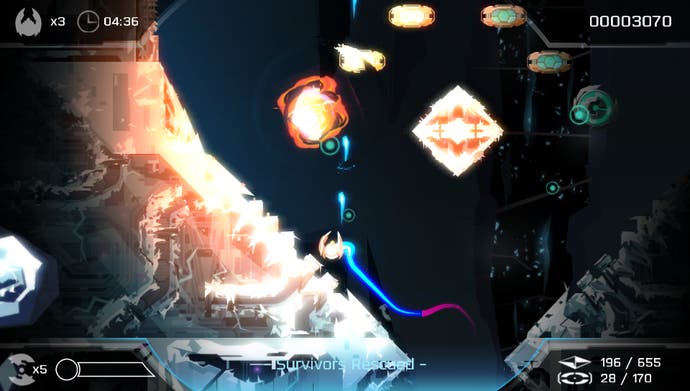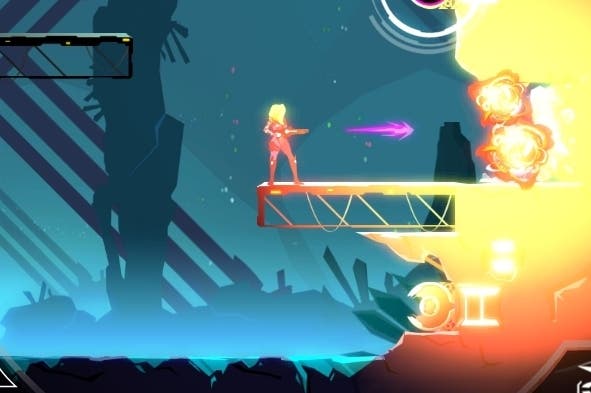The trouble with female protagonists, and the influence of J.J. Abrams: Introducing Velocity 2X
Futurlab's starbound follow-up introduces new mechanics, and new challenges.
The best way to encounter the original Velocity was to have it warp in from nowhere. It was a PlayStation Mini, coming from a relatively unknown studio, with little but a quietly stylish art style to mark it out. You might load it up expecting a competent retro-tinged space shooter in the style of Xenon. And, for a few obliging minutes, that's exactly what you'd get.
But then Velocity would start to pull weird tricks, allowing your spaceship to teleport through otherwise impassable barriers, and letting you squeeze a trigger to goose the throttle on the auto-scrolling screen. Soon you were dancing rings around your enemies as often as you were blasting at them and showboating your way across devious top-down mazes where every dead end was actually an invitation to zip past a wall and on to the next hurdle. Xenon was still in there, but it had been recalibrated as a kind of transdimensional game of hopscotch. Velocity was a treat.
And so, for a battle-hardened group of fans, Velocity 2X can't warp in from nowhere in quite the same way. FuturLab's sequel has expectations attached, along with a bigger budget and a larger team behind it. Hey, it's even had a bizarre brush with controversy, after a YouTube commenter objected to the fact that it has a female lead - and branded the lack of an option to play as a male protagonist "bad design".
"It's fascinating," says FuturLab's founder James Marsden. "It was baffling and fascinating, and I was morbidly attracted to the subject of this guy having a problem. It wasn't that he didn't want to play as a female. I totally understand that. I choose to play as Ken in Street Fighter, because back when I had hair, I used to have blond hair. It's the fact that he thought that it was objectively bad because we hadn't addressed the fact that, in his mind, most people like to play as a bloke, which is how he qualified things. He got challenged by other people on the thread, and his replies were, it's just the standard thing to do. Even when he was realising he was saying something a bit silly and admitted he would give the game a try despite the fact that it had a female lead, he still said it was an odd design choice."

In fact, the really odd design choice was waiting in the wings. The original Velocity had the very same female lead, but you'd never really know that unless you were paying attention during the fleeting story panels breaking up a game that was more interested in mechanics than narrative, let alone characterisations. Lt. Kai Tana's become so prominent in Velocity 2X because - whisper it - this time you can get out of the ship.
At first, this sounds like a bizarre proposition: a race-tuned top-down shooter that sporadically decides to be a side-scrolling platformer too? Having had a chance to play the latest build, however, it's starting to look like inspired decision making - because the side-scrolling platformer is so closely integrated with the top-down shooter.
In terms of the level lay-out, you'll still be blasting your ship through the cosmos, navigating space mazes, taking out chains of enemies and warping around hazards. Every now and then, however, you'll come across a dead end that you can't find a route past - not in your ship anyway.
Time to dock. And when you dock, you'll find yourself in the spaceboots of Lt. Tana, jogging through a series of compact 2D levels, taking down security panels in a numbered sequence so that you can get unlock the path ahead - and then get back in your ship.
Crucially, when on-foot, Lt. Tana can still teleport - albeit in a slightly reworked manner. "In a top-down game, you can teleport anywhere you want on screen," explains Marsden. "But the purpose of having a platformer is jumping and if you can teleport anywhere on the screen, it makes the whole process of jumping a bit futile. So we limited teleport to an arm's length range indoors. It still means that you can do fun teledashing, and combined with jumping it becomes the thing I think is really fun: you can jump up to a wall and then teledash through the wall."
On top of that, you can blast away at enemies using a twin-stick set-up, and you can still long-form teleport, too, by prodding and twanging at the Vita's display with a finger, Angry Birds-style, to launch telepods through gaps you couldn't otherwise fit past. You can speed up your pace to compensate for the fact that the screen no longer auto-scrolls in these sections, and you can slide under low gaps. Finally, to really keep you on your toes, there are even enemies to tackle in the on-foot sections, a sinister bunch known as the Vokh, who have shields that you must first disrupt with a tele-dash before laying on the laser fire.
Marsden admits that, while this was all pretty simple in principle, it's been tricky to implement. After all, the on-foot sections have to retain what the team refers to as the "special flow-state feel" of traditional top-down Velocity action.
"The actual mechanics for the platforming took a weekend, but we've been tuning for months and months since then," he says. "I can give you an example. We really wanted you to be able to jump up in the air, and then, as you're falling down towards a hazard that will kill you, teledash through it. I really wanted that in there. But no matter how much we tuned the distance that you teleport, the speed that you teleport, the thin-ness of the hazard, we just couldn't get it to feel right. You kept dying. It was in there for weeks with me just making it smaller and smaller. Then we finally got the Vokh in and that's the same deal, you have to run against the Vokh and teledash through him. I could do it every time, but other people would just die. There we were: two of the coolest things that were going to be in our game would not be in there because we couldn't make them work.

"Then I thought, why not make the player invincible when they're trying to teledash for a few frames? So you do actually collide with the Vokh most of the time, and you do actually collide with this hazard. But as long as you've got the teldash cursor open, you're invulnerable. Players just don't notice. They feel like they've done the action, and they feel like they got away with it. This stuff all matters because you build a level so it's easy to play through without dying, but every level's also tuned to be played at high speed. When you play the game back a second time with more skill, it's a different game."
Finally, as well as being a treat for speed-runners, Velocity 2X also promises to be a must-buy for fans of sci-fi cinema's latest infatuation: lens flare.
"The kind that J. J. Abrams uses all the time is called anamorphic lens flare," laughs Marsden. "It started with one of the team saying, 'Dude, in our new game can we have that cool lens flare that goes out at the sides?' Then Hussain Sheikh, our technical director, joined, and he'd worked on Split/Second as lead visual effects and he was responsible for the huge lens flare on that. Then the artist who created the benchmark images for the art style, he started talking about how we needed to get the J. J. Abrams in there. Because we were saying it so much, it just got shortened to JBramz. Now it's the JBramz engine.
"But yes," he concludes, "the game does have dynamic anamorphic lens flare. In fact, when J. J. Abrams recently apologised for sticking too much lens flare in the first Star Trek film, the whole studio went: Nooooooo! It was a sad day."
Marsden pauses. "Well, he did overdo it a bit, probably," he says. Uh-oh: another controversy beckons? "But the thing is, it looks so good."


